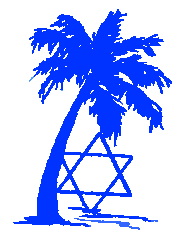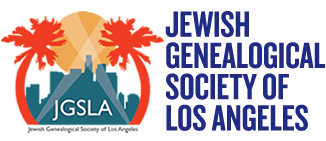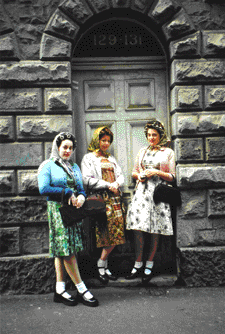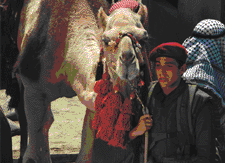August 2007
 |
JGSLA DATES AND UPDATESJEWISH GENEALOGICAL SOCIETY of LOS ANGELES August 2007 |
|
* Sunday, August 19, 2007, 12 noon * Highlights of the 27th IAJGS International Conference on Jewish Genealogy |
|||||||||
|
|||||||||
|
Member News Our condolences to Judie Rice, whose mother, Janet Schwartz Cynkus, died June 13 in Syracuse, NY, one day past her 98th birthday. Judie reports that she was the “go-to” person for genealogy and memoirs of Syracuse from 1909 to the 1980s. Her book, “Family” is in the JGSLA library. Our thoughts are with Robert (Bob) Katz, member and husband of Ronna Katz, who was seriously ill on the eve of his retirement. He is now at home recuperating, and we wish him well for a speedy and full recovery. Beginning Genealogy Resource Arnold “Arnie” Schwartz, a JGSLA board member, has donated a copy of his self-published book, “Beginning Genealogy: A Workbook” to our JGSLA library. It is packed full of valuable information. Look for it on our shelves. New Google Maps feature In addition to being able to view plain maps, satellite views, and traffic patterns, there is a new feature that allows users to view actual street-level images. It is easy to use. Go to Google Maps, and type in the destination you want to view. Once there, click the “Street View” button, and you will see some streets get a blue outline. Just drag the little yellow man into the area you want to view. Much of Manhattan can be viewed from street level, as well as some of the major routes in the outer boroughs New Website Reunites Families A new website has been launched to reunite families separated by the Shoah, [www.ShoahConnect.org]. ShoahConnect provides a tool to associate email addresses with the more than two million Pages of Testimony on Yad Vashem’s website [www.yadvashem.org], automatically matches people associated with the same Pages, and facilitates semi-private contact between them. The site is completely non-commercial. Anyone who submitted a Page of Testimony to Yad Vashem or is searching for lost relatives can potentially benefit from ShoahConnect. Immediate family members of deceased submitters are also encouraged to use the service. ShoahConnect aims to increase the number of dramatic family reunions that happen when close relatives discover each other through a Page of Testimony memorializing a common relative. A detailed discussion of ShoahConnect, including an interview with its creator, Logan Joseph Kleinwaks, can be found at [shorashim.blogli.co.il/archives/235]. ShoahConnect is available in English, with partial translations into Hebrew, Danish, Polish, and Portuguese, and more languages are being added by volunteers. For more information, visit [http://www.ShoahConnect.org]. |
Facts From the Stacks Barbara Algaze We are in the process of having various journals and newsletters in our collection bound in book form for the convenience of our members. Look for them the next time you are at the FHC. Completed ones include:
JGSLA at the Conference As has been the pattern in recent history, JGSLA was well represented at the recent 27 th IAJGS Conference on Jewish Genealogy, with approximately 57 registrants self-identifying as also being members of our society, including: Albert Algaze, Barbara Algaze, Jan Meisels Allen, Les Amer, Ron Arons, Adele Banner, Ronald H. Banner, Ruth Barnett, Barbara Illner Barrett, Joe Bein, Adar Belinkoff, Nancy Biederman, Leah Jordan Bisel, Warren Blatt, Hal Bookbinder, Susan Fisher Boyer, Sandy Bursten, Maida Dacher, Jerome Escover, Richard Fink, Alan Frank, Werner Frank, Leonard A. Friedman, Rebecca Geretz Friedman, Bobby Furst, Laura Gold, Nancy Goldberg, Sally Goodman, Mark Halpern, Paul Hefti, Barry F. Helfand, Richard H. Hoffman, Sonia Dennis Hoffman, David Blass Hoffman, Ph.D., Sara Hyman, Harriett Jane Zeman Kahan, Stanton Floyd Kahan, Debra Kay-Blatt, Vivian Linderman, Sandra Malek, Barbara Nevens, Stephanie Nordlinger, Bob Pachner, Mona Panitz, Bracha Gurevitch Rappaport, Morton Rappaport, Mark Reichard, Gayle Schlissel Riley, Joan Glanz Rimmon, Meryl Rizzotti, Helene Rosen, Lois Ogilby Rosen, Carolyn Kaiman Rosenstein, Nina Lenz Sitron, Pamela Weisberger, Geraldine Frey Mendoza Winerman and Edgar Zwieback |
||||||||
|
Godfrey Memorial Library and FamilySearch Centers Announce Partnership The Godfrey Memorial Library in Middletown, Connecticut has long been a valuable resource for genealogists. This private library houses thousands of genealogy books and also has an extensive collection of hand-written material, much of which is not available elsewhere. In addition, the Godfrey Library produces the American Genealogical-Biographical Index, or AGBI, is the equivalent of more than 200 printed volumes. This database contains millions of records of people whose names have appeared in printed genealogical records and family histories. The Godfrey Library has been digitizing much of the information and is now accelerating that effort. Even better, visitors to LDS FamilySearch Centers around the world will now have free access to the digitized material available. Godfrey Memorial Library Director Richard Black has now announced a partnership agreement between Godfrey Memorial Library and FamilySearch, the genealogy division of the Church of Jesus Christ of Latter-day Saints. The Godfrey Library’s online materials will now become available at 4500 FamilySearch facilities around the world. Here is the text of that announcement, as posted on the Godfrey Memorial Library’s web site at [www.godfrey.org/announce.html]. Director Richard Black is pleased to announce a partnership agreement between Godfrey Memorial Library and FamilySearch, “We are excited to include Godfrey Memorial Library to our list of premium databases or services offered throughout FamilySearch centers worldwide. They provide some premier resources that will certainly be of great value to FamilySearch center patrons,” said Paul Nauta, manager of public affairs for FamilySearch. “In return Godfrey Memorial Library will significantly broaden its reach and awareness by being introduced to scores of researchers through 4500 FamilySearch facilities in over 70 countries,” Nauta added. Many new genealogical websites and services are coming online everyday, making more and more records available. FamilySearch is teaming up with these online service providers like Godfrey Memorial Library to introduce patrons to these exciting services and provide even greater online access to the world’s genealogical records. These premium services are available for free in family history centers, the Family History Library and FamilySearch operated centers. FamilySearch is committed to providing as much genealogical data as possible to its patrons quickly and economically. The accomplishment of this initiative will come in part from its own programs, and others will come from affiliations with service providers like Godfrey Memorial Library. This will allow maximum and efficient use of industry resources. Godfrey Memorial Library can greatly increase awareness of its services through the FamilySearch public distribution channels. FamilySearch workers will innately help patrons use/become familiar with Godfrey’s online services. Some limited promotion by Godfrey will be allowed to properly introduce patrons to its full range of services. Patrons to FamilySearch facilities get access to Godfrey’s databases-an otherwise fee-based online service. The FamilySearch resources are frequented by mostly enthusiasts and professional researchers; many of which may elect to subscribe personally to the services for home or remote access. |
Indexing of Records by LDS Gordon Hillman In talking with an associate who has been directly involved in the organizing of the digitizing and indexing of records held by the Family History Library I can give you some insight. The project is mammoth and you need to realize the big picture. This project will take several years to complete because it involves the digitizing and indexing of over 2 million rolls of microfilm. There is a requirement for tens of thousands of volunteers to assist (I have even heard they require 100,000 volunteers). They have a number of concerns about images and indexes that are already on the Internet. One concern is the fees that people must pay to access the information and another concern is the accuracy of the indexing. Some of the indexing has been done off-shore with poor quality control. Another concern is the quality of the images. Also, there are legal and copyright concerns of indexes by other parties who operate on a subscription basis. The new indexing program requires that at least two people index the exact same records, the indexes are then compared for differences and if necessary supervisory personnel will correct any differences. The index will be more complete and the degree of accuracy will be improved. It seems reasonable that they start with the most used and easiest records and then move to the less used ones and more complicated. US records are probably the most frequently used records so they are starting there. Hungarian records are down the list and require a higher level of expertise to deal with Latin and Hungarian so they will follow later. However, when they are done, you will be able to view not only Hungarian church records digitally on your home computer but also those records will be fully indexed. Another part of the project is to have archives and libraries around the world co-operate and either provide digital images or allow for digital records to be made so they become available to the public. If archives and Libraries already have this type of record available there will be links on familysearch to send the researcher to their sites provided the information is free or a minimal charge is applied by that site. The difficulty for us will be waiting until our specific records become available in this process. |
||||||||


